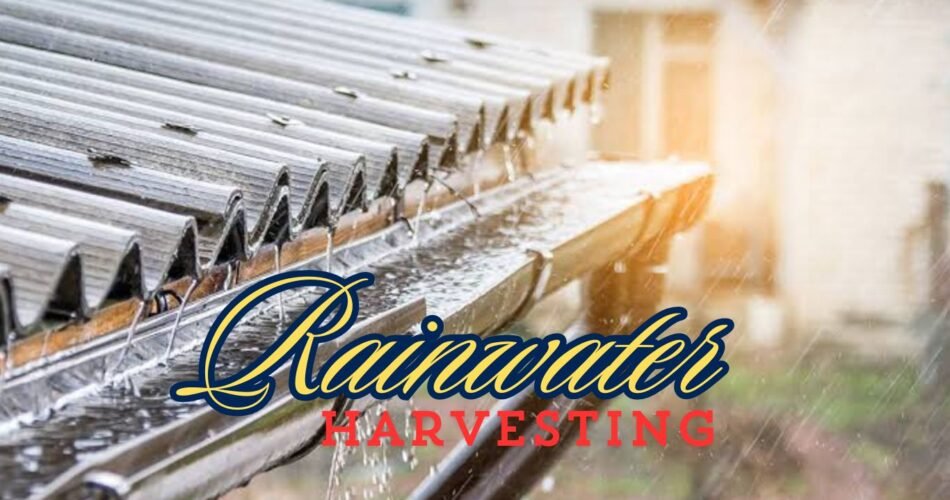This blog provides information about Rainwater Harvesting System. In the start, it explains what is Rainwater Harvesting. Then it explains why we need to do it. It also explains Types of Rainwater Harvesting Systems. Then it elaborates the Components of Rainwater Harvesting. It explains the Benefits of Rainwater Harvesting in detail. In the end, It explains the Methods, Advantages and Disadvantages of Rainwater Harvesting. This blog contains Benefits, Types, Components, Advantages and Disadvantages of Rainwater Harvesting RWH.
What is Rainwater Harvesting?
Rainwater harvesting is the simple process or technology used to conserve rainwater by collecting, storing, conveying and purifying of rainwater that runs off from rooftops, parks, roads, open grounds, etc. for later use. Here, let us have a look at the diagram of rainwater harvesting system.
This method can avoid wastage of rainwater and helps us to utilize rain water for our daily life purposes such as sanitation. This water brings us towards sustainability because we ourself collect the water and use it in our homes.
Gallons of water comes to the Earth’s surface in the form of rain and so it is added to the drainage system within few minutes after the rain stops. Rainwater harvesting helps us to prevent this water from wastage also this technique teaches us sustainability and provide us lessons to prepare our own resources.
This blog is a detailed description of Rainwater Harvesting RWH, Reason, Types, Components, Advantages and also Disadvantages.
Why do we Harvest Rainwater?
The rainwater harvesting system is one of the best methods practiced and followed to support the conservation of water so as we know Today, scarcity of good quality water has become a significant cause of concern. However, rainwater, which is pure and of good quality, can be used for irrigation, washing, cleaning, bathing, cooking and also for other livestock requirements.
This helps us to save freshwater for drinking and also for cooking purposes and utilize rainwater for other household needs. Many nations are facing water shortage and water scarcity. This technique is the best way to from all of these water crisis.
Rainwater harvesting reduces your dependency on others, or different appliances, also by providing a large amount of water for use. This water with slight treatment and filtration, is able to use for irrigation, cleaning, sanitation and other such household purposes.
Types of Rainwater Harvesting Systems:
Following are some types of Rainwater Harvesting Systems:
Rooftop Rainwater Harvesting:
This involves collecting rainwater from the roof of a building and directing it to a storage tank or recharge pit. This can be in the form collection tanks on the roof and its supply is in the form of pipes when this water is needed. A lot of water stays on the roofs after rain, we can collect that and use that water in our daily routine.
Surface Runoff Harvesting:
This method collects water from surface runoff, such as streets and open areas, and channels it to a storage or recharge system. Streets and roads with poor drainage systems, have a huge amount of standing water after heavy rains. We can collect that water through special channel system and utilize this water after slight treatment.
Infiltration Pits and Trenches:
These structures help in recharging groundwater by allowing rainwater to percolate into the soil. Infiltration is the absorption of water into the surface so we can install percolation systems in pits and trenches to absorb excessive water from the roads, streets, parks and other such places. This technique can collect large amount of water.
Components of a Rainwater Harvesting System
Catchment Area:
This is typically the roof of a building where rainwater is collects.
Gutters and Downspouts:
These channels direct the collected water from the roof to the storage system.
Filters:
Filters are used to remove debris and contaminants from the collected water.
Storage Tanks:
These tanks store the filtered rainwater for future use.
First Flush Diverters:
These devices are used to divert the initial runoff, which may contain contaminants, away from the storage tank.
Distribution Systems:
These systems distribute the stored water to various points of use.

Benefits of Rainwater Harvesting:
Following are the benefits of Rainwater Harvesting:
Water Conservation:
Reduces the demand on existing water supply systems and conserves water so its use decreases water demands and help in conservation of freshwater.
Reduces Flooding and Erosion:
Helps in managing stormwater runoff, reducing the risk of flooding and soil erosion. If most of the rainwater is collect by rainwater harvesting so it will help us to avoid flood and erosion of valuable nutrients from the soil.
Cost Savings:
Lowers water bills and reduces reliance on municipal water supplies so this helps you to reduce your bills and cost of the appliances that use water to in their working.
Groundwater Recharge:
Replenishes groundwater levels, especially in areas where groundwater is being depleted. If we will not take water from the groundwater table, it will be recharged and it won’t be lowered.
Sustainable Water Management:
Promotes sustainable use of water resources and helps in managing water scarcity so through rainwater harvesting we build a sustainable way of using water by collecting our own water for our daily activities.
These are few benefits of Rainwater Harvesting. This blog contains Components, Benefits and Types of Rainwater Harvesting RWH.
Challenges and Considerations:
Following are some challenges and considerations for Rainwater harvesting:
Initial Costs:
The setup cost for rainwater harvesting systems can be high, though it can be offset by long-term savings. Everyone cannot afford Rainwater harvesting systems personalized for their homes. But we can set up these systems on community level.
Maintenance:
Regular maintenance is requires to ensure the system functions efficiently and to prevent contamination so a little negligence will cause the water to be waste or contaminate. There is a need of continuous monitoring for this system.
Water Quality:
The quality of harvested rainwater may contain pollutants, so proper filtration and treatment are necessary for potable uses. Pollutants and contaminants can enter this water anytime. So we should monitor it and filter the water before use.
These were some challenges in setting up Rainwater Harvesting System.
Methods of rainwater harvesting:
The different methods of rainwater harvesting include:
Rooftop rainwater harvesting:
The rooftop becomes the catchments, and also the rainwater from the building and houses are collected. The components of the rooftop rainwater harvesting are:
First, flush.
Transportation.
Catchment.
Filter.
Surface runoff harvesting:
It is the system that collects rainwater, which flows away as surface runoff so the runoff rainwater is caught and used to recharge aquifers by adopting appropriate techniques.
Advantages of Rainwater Harvesting
The benefits of the rainwater harvesting system are below:
Less cost.
Helps in reducing the water bill.
Decreases the demand for water.
Reduces the need for imported water.
Promotes both water and energy conservation.
Improves the quality and quantity of groundwater.
Does not require a filtration system for landscape irrigation.
This technology is relatively simple, easy to install and operate.
It reduces soil erosion, storm water runoff, flooding, and also pollution of surface water with fertilizers, pesticides, metals and other sediments.
It is an excellent source of water for landscape irrigation with no chemicals, dissolved salts and also
free from all minerals.
Disadvantages of Rainwater Harvesting:
Following are the Disadvantages of Rainwater Harvesting:
Regular maintenance is the requirement.
Requires some technical skills for installation.
Limited and no rainfall can limit the supply of rainwater.
If not installed correctly, it may attract mosquitoes and other waterborne diseases.
One of the significant drawbacks of the rainwater harvesting system is storage limits.
The importance of rainwater harvesting
Rainwater harvesting is a sustainable process that helps in preserving water for future needs. Water scarcity is a major concern in today’s scenario. The process of rainwater harvesting is a good way to conserve water. This blog contains Types, Benefits and Components of Rainwater Harvesting RWH in detail.

To learn more, click the links below:


Comments